Early morning at Garris Landing; you have to be early if you are heading out to Cape island with the loggerhead program crew. I was earlier than the rest of the crew, and found the automatic gate to the landing closed. I parked and walked in to take a look at the 5:30AM sky. In the east Jupiter and Venus shone brightly in conjunction with Aldebaran radiating a reddish hue. Light was infiltrating from the horizon, signaling the coming of dawn. A second vehicle arrived – Judy Beahn from Folly Beach, another volunteer I have worked with during hatchery building for the past several years. She told me about the two poached nests on Folly and the investigation. The gate finally opened for us, and the rest of our crew for the day filtered in to complete our preparations. The crew: staff Dan Ashworth and BIlly Shaw, interns Keith Fuller and Ravin Thomasson, and Judy and I.
Since last I had seen Dan, he had been promoted to Refuge Biologist, and I congratulated him. I had not seen Billy since winter, and I talked to him about the busy season and the heat. Due to the proliferation of nests there had been many long days, and both Billy and Ravin had worked the day that Cape Island and Lighthouse Island totaled forty nests.
The turning of the tide has become more important than ever in the logistical challenges of the loggerhead program. Getting up and down the strand on ATV’s used to be the number one factor determining access to beaches, but now it is getting the boat to and from South Cape. The crew must split into three: 2 on Lighthouse Island, 2 on South Cape, and 2 on the main Cape Island, with the last crew taking the boat, and making all the drops and pickups of the crew. Billy and Dan conferred, and Dan and intern Keith went to Lighthouse Island (see Keith’s photo posted on Facebook of a hatchling recovered in hatched nest inventory – Dan in background), Billy and Judy to main Cape Island, and myself and intern Ravin to South Cape. As Billy dropped us off, he asked me if I remembered how to inventory nests (already hatched). I echoed an earlier statement of his about impaired memory, and he replied “Yeah, the Sixties”.
(Note: “A” marks Cape Point). The Google Map of South Cape must have been an image captured sometime between when Hurricane Irene raked the island with storm surf (see Flattening of an Island), creating three breaches, and the present. One of the breaches has closed, and as can be seen in this image there is still a small breach in the middle of South Cape. It has now closed, and we easily passed over the sands that have filled in. Arriving at the site where the ATV is kept, the only place with substantial dunes intact, the rows of relocated nests were impressive, and indicative of the lack of viable nest locations on the island.
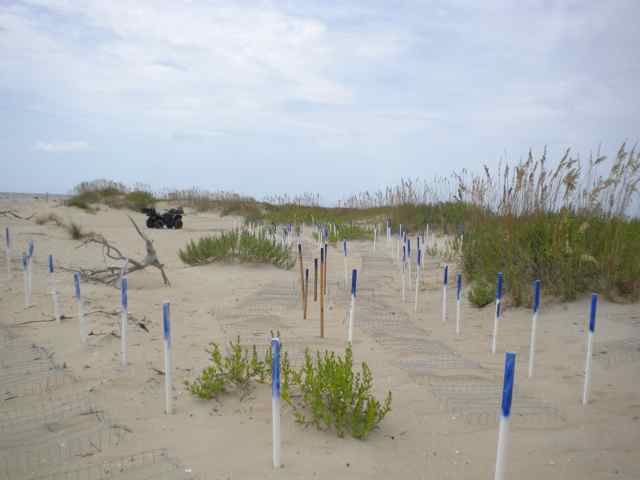 I had earlier joked with fellow crew members about my being a “third-stringer coming off the bench”, but there was a bit of reality to this humor. I have not been a regular volunteer for the nest finding and relocation – I had just done this occasionally over the past seven years, unlike the regular volunteers who work one day a week in the season. The regular staff have all the skills and responsibilities for the program’s operation. The interns coming in for a season have the time after about six weeks to develop the necessary skill set to work independently and productively.
I had earlier joked with fellow crew members about my being a “third-stringer coming off the bench”, but there was a bit of reality to this humor. I have not been a regular volunteer for the nest finding and relocation – I had just done this occasionally over the past seven years, unlike the regular volunteers who work one day a week in the season. The regular staff have all the skills and responsibilities for the program’s operation. The interns coming in for a season have the time after about six weeks to develop the necessary skill set to work independently and productively.
Nest location appeared a formidable challenge, in that the wind had blown hard from the southwest all night, and the usual tracks of crawls were barely visible below the high tide line. Above it, the drifting sands left few clues, at least for the novice. Ravin was our nest locator, and began piecing together what few clues there were on the sandy area near Cape Point. I was most surprised when the first hole she dug after probing hit a nest. As I learned about this young woman throughout the morning, her internship with USFWS was occurring after her freshman year in school. I commented that about 90% of sophomores are clueless about what they want to do (in retrospect, in my day, I had clearly and firmly been in the 90%).
Besides being a fast learner, Ravin had obviously received excellent training on Cape Island doing fieldwork four days a week. 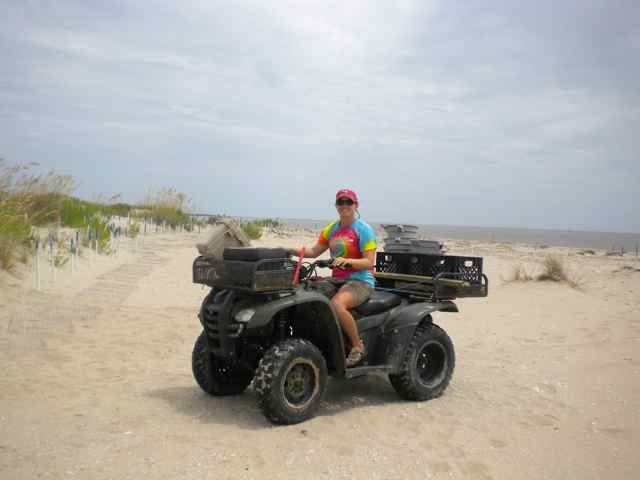 And she had fine teachers – BIlly Shaw and Jerry Tupacz, who have done it for years, and now Dan Ashworth. This site has provided students an excellent training ground, with many interns going on to biologist positions in various organizations. A prime teacher for many has been Sarah Dawsey, now refuge manager. Sarah’s work ethic has infused all the staff and volunteers, and most of the interns over the years – clearly Ravin and Keith. There is no getting around the fact that the work at Cape Island is often difficult, uncomfortable, and unrelenting.
And she had fine teachers – BIlly Shaw and Jerry Tupacz, who have done it for years, and now Dan Ashworth. This site has provided students an excellent training ground, with many interns going on to biologist positions in various organizations. A prime teacher for many has been Sarah Dawsey, now refuge manager. Sarah’s work ethic has infused all the staff and volunteers, and most of the interns over the years – clearly Ravin and Keith. There is no getting around the fact that the work at Cape Island is often difficult, uncomfortable, and unrelenting.
Beside finding and relocating three nests, we looked for nests hatching out from the previous night, since they were now hatching everyday. We located one down the beach in an area without dunes, but initially saw no tracks heading away from it. Ravin lightly reached her hand through the caging, and felt down in the sand, bringing up a hatchling, alive but quite lethargic. 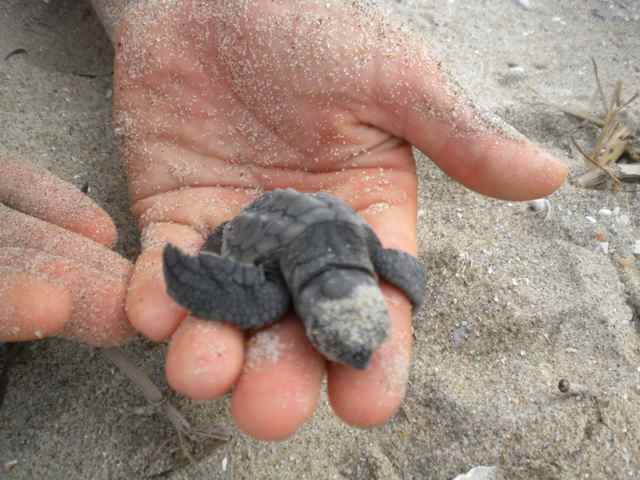 In a few minutes above the sand the one live hatchling was revived enough for its sea baptism. In looking around the hatched nest, Ravin walked toward the backside of the island, spotting tracks and finding the answer to where the hatchlings went.
In a few minutes above the sand the one live hatchling was revived enough for its sea baptism. In looking around the hatched nest, Ravin walked toward the backside of the island, spotting tracks and finding the answer to where the hatchlings went. 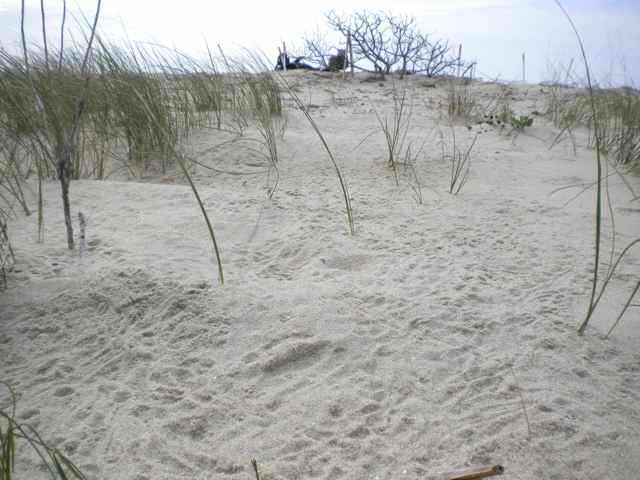 WIth no dunes to provide the backdrop where the ocean would be the only horizon, they chose wrong in mass, heading into the clutches of grasses they could not entangle from, and where predators fed on their defenseless bodies. We found and counted 106 casualties. It motivated us to scrounge pieces of wood along the beach, and provide backing boards for nests lacking proper dunes to steer hatchlings toward the ocean. We later hustled to place these boards prior to our pickup at the backside of Cape Point.
WIth no dunes to provide the backdrop where the ocean would be the only horizon, they chose wrong in mass, heading into the clutches of grasses they could not entangle from, and where predators fed on their defenseless bodies. We found and counted 106 casualties. It motivated us to scrounge pieces of wood along the beach, and provide backing boards for nests lacking proper dunes to steer hatchlings toward the ocean. We later hustled to place these boards prior to our pickup at the backside of Cape Point.
We found the last nest in an unlikely place – in the sands adjacent to the breach. The tide was past high, and there was no beach to approach this area. In fact the erosion has continued along this part of the island where a spit extended into the marsh on the backside, but now the waters had created a sharp scarp. As we crossed an area of thorny vines, Ravin alerted me to the scarp beginning to break off beneath my weight, with a four-foot drop awaiting. Past the brambles, Ravin found the nest, and I had never seen the deposited eggs so close to the surface – only inches deep. With the erosion occurring so fast, this nest might wash away before the required period of egg development. Ravin caught a whiff of an already identified dead turtle nearby. Looking over the breach, there was no evidence it was filling in, but the contrary. The beginning of the ebb was already ripping out. It seemed to be morphing into an inlet. 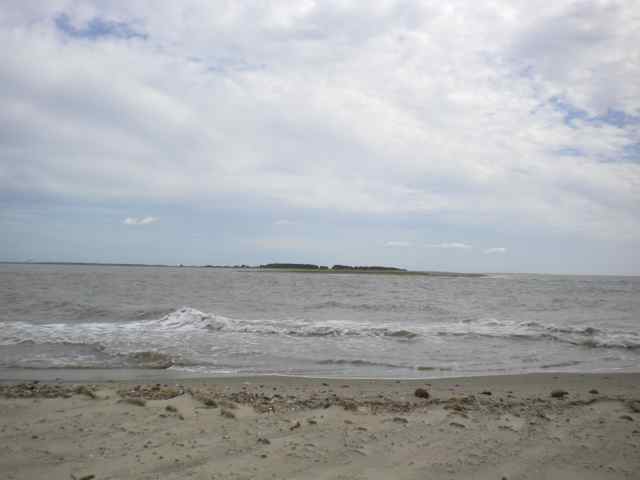 As with much else around South Cape, the changes were stunning, and as Billy said later, happening daily. My brain attempted to process the changes throughout the morning.
As with much else around South Cape, the changes were stunning, and as Billy said later, happening daily. My brain attempted to process the changes throughout the morning.
All the pickups were made without incident. The skiff ride in the solid southwest wind and ebbing tide sent sheets of spray on us, and the flat bottom of the skiff pounded the chop and our brains in the roughest sections. After our return from McClellanville to Garris Landing, the work continued for the staff and interns – putting away equipment, washing up the skiff, and beginning the record keeping for the data collected today, including the nine nests and inventories completed. Before leaving, we chatted about the season. The meaning of the volume of the nests was discussed, along with more results from the genetic study. It was clearly a banner year, yet what was the banner saying? Was it marking the turning of the tide for this endangered species? Had all the efforts in Cape Romain over the years through the loggerhead program contributed to these gains? Certainly no “Mission Accomplished”. There were clear reasons for optimism, yet premature for a victory banner to be printed. Most assuredly, “The Work Will Continue”.
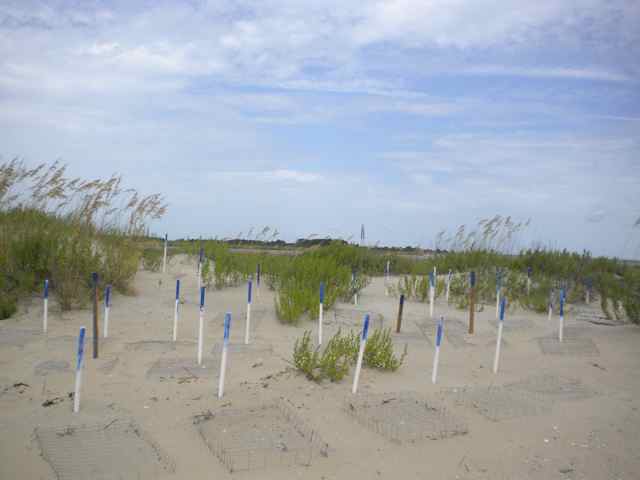
So good Bob…thank you … c
My stomach sinks and my heart breaks reading about 106 hatchling casualties from one nest alone, but I must remember this is nature’s way, and also more importantly appreciate all the work that the staff, interns and volunteers of Cape Romain give to these precious creatures. Keep up the great work, everyone!
It is nature’s way, as is the reduction of the island through Irene’s storm surf. Before the beginning of the loggerhead program on Cape Island, the predation of nests and hatchlings decimated the future loggerhead population.
I volunteer @ Loggerhead Marinelife Center in Juno Beach Fl. I’m impressed with your efforts. We often use gps to locate nests. This helps eliminate poaching. keep up the good work!
The great work is being done by the superb staff, interns, and incredible volunteer community.
sad about the loss of 106 and think your work to shunt hatchlys toward ocean may do the trick….. hopefully!
Thank you for taking the time to write so descriptively. It breaks my heart to read of all the hatchlings lost to predators, storms, etc., but, as you stated, that’s a part, although a very tough part, of nature. However, your efforts and the efforts of Sarah, Dan, the interns and all the other volunteers do make a difference. Thank you for all your hard work!